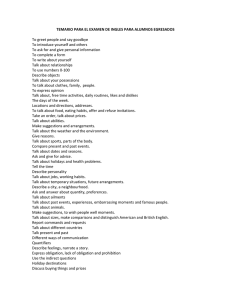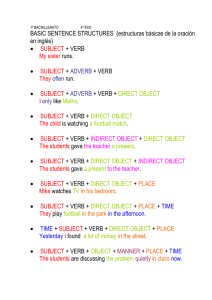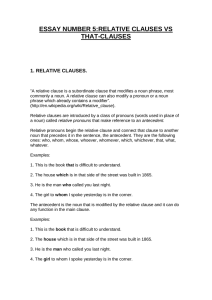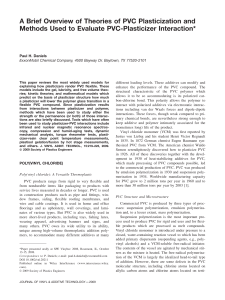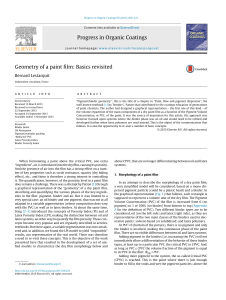The Phasal Verb Construction in Seri
Anuncio
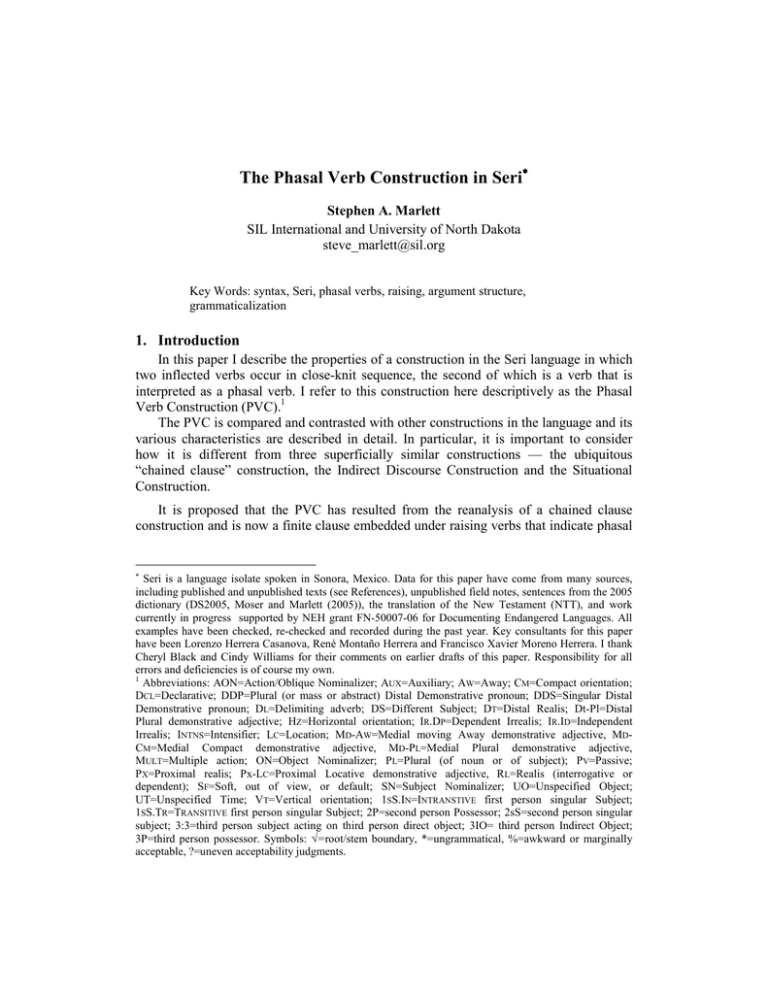
The Phasal Verb Construction in Seri∗ Stephen A. Marlett SIL International and University of North Dakota [email protected] Key Words: syntax, Seri, phasal verbs, raising, argument structure, grammaticalization 1. Introduction In this paper I describe the properties of a construction in the Seri language in which two inflected verbs occur in close-knit sequence, the second of which is a verb that is interpreted as a phasal verb. I refer to this construction here descriptively as the Phasal Verb Construction (PVC).1 The PVC is compared and contrasted with other constructions in the language and its various characteristics are described in detail. In particular, it is important to consider how it is different from three superficially similar constructions — the ubiquitous “chained clause” construction, the Indirect Discourse Construction and the Situational Construction. It is proposed that the PVC has resulted from the reanalysis of a chained clause construction and is now a finite clause embedded under raising verbs that indicate phasal ∗ Seri is a language isolate spoken in Sonora, Mexico. Data for this paper have come from many sources, including published and unpublished texts (see References), unpublished field notes, sentences from the 2005 dictionary (DS2005, Moser and Marlett (2005)), the translation of the New Testament (NTT), and work currently in progress supported by NEH grant FN-50007-06 for Documenting Endangered Languages. All examples have been checked, re-checked and recorded during the past year. Key consultants for this paper have been Lorenzo Herrera Casanova, René Montaño Herrera and Francisco Xavier Moreno Herrera. I thank Cheryl Black and Cindy Williams for their comments on earlier drafts of this paper. Responsibility for all errors and deficiencies is of course my own. 1 Abbreviations: AON=Action/Oblique Nominalizer; AUX=Auxiliary; AW=Away; CM=Compact orientation; DCL=Declarative; DDP=Plural (or mass or abstract) Distal Demonstrative pronoun; DDS=Singular Distal Demonstrative pronoun; DL=Delimiting adverb; DS=Different Subject; DT=Distal Realis; Dt-Pl=Distal Plural demonstrative adjective; HZ=Horizontal orientation; IR.DP=Dependent Irrealis; IR.ID=Independent Irrealis; INTNS=Intensifier; LC=Location; MD-AW=Medial moving Away demonstrative adjective, MDCM=Medial Compact demonstrative adjective, MD-PL=Medial Plural demonstrative adjective, MULT=Multiple action; ON=Object Nominalizer; PL=Plural (of noun or of subject); PV=Passive; PX=Proximal realis; Px-LC=Proximal Locative demonstrative adjective, RL=Realis (interrogative or dependent); SF=Soft, out of view, or default; SN=Subject Nominalizer; UO=Unspecified Object; UT=Unspecified Time; VT=Vertical orientation; 1SS.IN=INTRANSTIVE first person singular Subject; 1SS.TR=TRANSITIVE first person singular Subject; 2P=second person Possessor; 2sS=second person singular subject; 3:3=third person subject acting on third person direct object; 3IO= third person Indirect Object; 3P=third person possessor. Symbols: √=root/stem boundary, *=ungrammatical, %=awkward or marginally acceptable, ?=uneven acceptability judgments. aspect.2 The newly formed phasal verbs are identical in form to the verbs that gave origin to them. However, the syntax of these phasal verbs no longer matches their morphology in that those which are etymologically and morphologically transitive are functioning as intransitive phasal verbs. 2. The Phasal Verb Construction contrasted with others The chained clause construction is one of the most common types of sentences in Seri.3 The typical pattern is schematized in (1) ― a series of dependent clauses followed by an independent clause. (1) Dependent,n Independent. While sentences in narratives may have many dependent clauses, a simple example with only three is given in (2). As is typical, none of the dependent clauses in (2) has a subordinator. The verbs of the dependent clauses are underscored in (2). (2) a. b. c. d. Ox tpacta ma, thus RL-be DS cmaax now hapx outside taax iti tiij, DDP 3P-on RL-sit taailx RL-release-MULT imóoctam, comcáac 3:3-PX-look.at-PL person.PL ma x, DS UT coi. the.PL ‘Entonces, sentada allí, demostró su poder mágico, y la gente la miraba.’ ‘Then, sitting there, she demonstrated her magical powers, and the people watched her.’ (ES2007, cmaam ipca quiho 8w) In sentences with chained clauses, the grammatical subject may vary from one clause to the next. When the referent of the subject changes, an overt marker appears near the end of the dependent clause.4 This happens twice in example (2) — between clauses (2a) and (2b) and between (2c) and (2d) — and so the Different Subject marker ma appears at the end of (2a) and near the end of (2c).5 When the referent of the subject does not change, as between (2b) and (2c), no overt marker appears. Embedded indirect discourse is superficially quite similar to the dependent clauses illustrated above except that no Different Subject marking occurs before the speech verb 2 This construction shares some properties with the serial verb construction (see Dixon and Aikhenvald (2006) and the work cited there) but does not match the prototype of that construction. 3 Longacre (1972) introduces the term “clause chaining” and characterizes it based on languages of Papua New Guinea. Longacre (1985) demonstrates that this is a type of structure found in other parts of the world also. See also Hale (1991) for a discussion of similar facts in Misumalpan languages of Central America. 4 See Moser (1978), Marlett (1981), and Farrell, Marlett and Perlmutter (1991) for details. 5 In irrealis clauses, the Different Subject marker is ta. The extremely common enclitic x in (2c) is the only word which may appear after the Different Subject marker; in many cases it seems to indicate a lack of specific time, but its precise meaning is unclear. when there is a change in subject. Therefore the morpheme ma is ungrammatical between the (a) and (b) clauses of the following sentences.6 (3) a. Tmoquéepe RL-sick (*ma), b. imíii. 3:3-PX-tell.PL DS ‘Le(s) dijeron que estaba enfermo/a.’ ‘They told him/her/them that s/he was sick.’ (4) a. Intmoquéepe (*ma), 2SS-RL-sick DS ‘Te dijo que estabas enfermo/a.’ ‘S/he told you that you were sick.’ b. ma miih. 2SDO PX-tell (5) a. b. him miih. 1SDO PX-tell (6) a. b. him miii. 2SDO PX-tell.PL Intmoquéepe (*ma), 2SS-RL-sick DS ‘Me dijo que estabas enfermo/a.’ ‘S/he told me that you were sick.’ Ihptmoquéepe (*ma), 1SS.IN-RL-sick DS ‘Me dijeron que yo estaba enfermo/a.’ ‘They told me that I was sick.’ The phrase comcáac himcoi in examples (7i-ii) is the subject of the second verb ― the speech verb ― and must appear initially or finally in these examples. Example (7iii) shows that it cannot occur between the two verbs of the sentence. (7) i. ii. Comcáac himcoi trooqui zo person.PL DT-PL vehicle a Trooqui vehicle zo a 1SS.TR-RL-steal htcooz, iii. * Trooqui zo vehicle a 1SS.TR-RL-steal htcooz, htcooz (*ma), 1SS.TR-RL-steal him miii, 2SDO PX-tell.PL comcáac person.PL DS comcáac person.PL him miii. 2SDO PX-tell.PL himcoi. DT-PL himcoi him miii. DT-PL 2SDO PX-tell.PL ‘Esas personas me acusaron de haber robado un carro.’ ‘Those people accused me of having stolen a car.’ What I call the Situational Construction has two clauses with coreferential subjects. The first clause looks just like any ordinary dependent clause and contains the major information about what is actually happening. The second clause follows a formula, using one of the following phrases (although the verb may be in a tense other than that shown in these examples): toc cötiij (there 3IO-RL-sit), toc cötap (there 3IO-RL-stand), toc cotom (there 3IO-RL-lie), toc cötoii (there 3IO-RL-be.PL). This is illustrated by the examples that follow. Sometimes it seems inappropriate to render the second clause literally in the tran6 For the same reason, Different Subject marking does not appear at the end of clause (8b) preceding yoque, a form of the verb for saying that now usually functions as an evidential indicating that the preceding information is what the ancestors have said — most commonly used in traditional stories and historical narratives. slation. In (10), the construction occurs twice: in clauses (10b-c) and in clauses (10d-e). (8) a. … coléequi teetol b. toc cötap, c. yoque. upwards RL-push there 3IO-RL-stand DT-US-say ‘… estaba allí parado empujando hacia arriba [en el techo de la cueva], se dice.’ ‘… he was standing there pushing upwards [on the roof of the cave], it is said.’ (Conejo_Coyote 17-18) (9) a. Iistox theemloj b. toc 3P-spirit-PL RL-stink-PL there ‘Estaban enojados, …’ ‘They were angry, …’ (Dos_Hermanos 4.1) (10) a. b. Hant z iti place a on e. DS … tiij, tooizj c. ziix hast iizx ano coom chuckwalla toc there ma, 3IO-RL-be.PL RL-sit RL-UO-grind d. cötoii cöquiij iha. 3IO-SN-sit DCL com the.HZ toc cötiij ma, there 3IO-RL-sit DS mos cmiique quih thaa also person the.SF RL-be x, UT ‘Ella estaba sentada en un lugar, estaba moliendo [fruta], la iguana también era una persona.’ ‘She was sitting in a place, she was grinding [fruit], the chuckwalla also was a person.’ (ES2007 acaam_ccaa 13) What is noticeable in this construction is first, the two clauses are generally spoken in fairly quick succession with a lowered intonation contour on the second clause, and second, the second clause adds little to the propositional meaning. Notice that the information that the woman was sitting has already been expressed in clause (10a). The topic of this paper, the Phasal Verb Construction, has two verbs in it, which I refer to as V1 and V2. So far as I have been able to determine, only three verbs in the language may appear as V2 in this construction. One of the verbs is √axi, a transitive accomplishment verb meaning ‘make, create (an object)’ — always with the idea of completion — when it is used in many simpler sentences (Moser and Marlett 2005); it is not used for ‘make’ when the creation is incomplete. But in the construction considered here it has been grammaticalized to mean ‘finish, complete (an action)’.7 It is not used for anything like a causative construction. As demonstrated below, the subject in the PVC 7 This verb also has the meaning of ‘finish’ in the following sentence which is different structurally from the other sentences in this paper. The first clause is headed by a deverbal noun, typical of most complement clauses. (i) ¿Inyáhitim intáxi? 2P-AON-UO-eat-MULT 2SS-RL-finish ‘¿Has terminado de comer?’ ‘Have you finished eating?’ may or may not be agentive. When the verb is used in its concrete sense, however, the subject must be agentive. Another verb that may appear as V2 is √acatx, a transitive verb that means ‘release, set free, let go, let loose, abandon (a person or object)’ in other contexts. In the PVC it has been grammaticalized to mean ‘stop (doing an action)’. As with the verb √axi, the subject of √acatx in the PVC is not necessarily agentive.8 The third verb that may appear as V2 is √ajöc, an intransitive verb which is not used alone at all.9 The construction with this verb means ‘continually be or do’, commonly translated with ‘always’, and typically takes the enclitic “delimiting” adverb oo (no clear meaning) as well as third person indirect object marking (the prefix co- or its allomorph cö-, for no obvious reason), as seen in the examples below. The subject is not necessarily agentive. This verb is glossed ‘continually’ in the examples that follow. Consider (11)-(15), which are three sentence fragments that contain the PVC. One sequence of words which I label S1 has been bracketed in each example. Although in each case the bracketed part could be a complete dependent clause, I am not claiming that at this point that it is a constituent. Likewise, the verb of finishing, stopping or continuing has also been bracketed and labeled S2. The discussion which follows looks at the properties of these sequences and the verbs in them (V1 and V2, respectively). (11) [ … tiix ihtíp ] S1 [ ihtáxi, ] S2 … 1SS.TR-RL-finish ‘… cuando terminé de enderezarla, …’ ‘… when I finished straightening that one, …’ (DS2005, quiip) DDS 1SS.TR-RL-straighten (12) [ Ox tee ] S1 [ itáxi, ] S2 3:3-RL-finish thus RL-say ‘Cuando terminó de decir así, …’ ‘When he finished saying thus, …’ … (Conejo_Puma 11.1) (13) [ Zo hpoohit ] S1 [ ihpóoxi, ] S2 … a/one 1SS.TR-IR.DP-eat 1SS.TR-IR.DP- finish ‘Cuando termino de comer una [cabeza], …’ ‘When I finish eating one [head], …’ (Conejo_Puma 13.1) (14) [ Tapca ] S1 [ itácatx ma x, ] S2 xepe com xiimj. RL-rain 3:3-RL-release DS UT sea the.HZ EM-clear ‘Cuando deja de llover, el mar está claro.’ ‘When the rain stops, the sea is clear.’ (DS2005, quiimj) 8 This verb is also commonly used with a complement headed by a deverbal noun. 9 This verb may also occur with a complement headed by a deverbal noun. (ii) …, hai cop cói iixaj oo cötajöc wind the.VT still 3P-AON-strong DL 3IO-RL-CONTINUALLY ‘… el viento seguía siendo fuerte, …’ ‘… the wind continued to be strong …’ (Ac 27:18) ma, … DS (15) [ Hax ihpóoitom ] S1 [ cohpóojöc oo, ] S2 … just 1SS.IN-IR.DP-talk 3IO-1SS.IN-IR.DP-continually DL ‘Aunque yo platique continuamente …’ ‘Even if I talk continually, …’ (DS2005, cöcajöc) 3. Properties of the PVC The following properties hold for the PVC: 3.1. Property 1: The verb in S1 is always in medial morphology. Medial morphology is the finite verb morphology that is typical of dependent clauses of the chained clause construction in the language, as in (2), of embedded indirect discourse, as in (3), and of the first clause of the Situational Construction, as in (8). The verb in S1 in the PVC is always in medial morphology. Therefore the verb of S1 is either conjugated with t- (realis), as in (11) above, or po- (dependent irrealis, with the allomorphs p- and poo- in certain other situations), as in (15) above. More examples are given immediately below. Examples with √axi: (16) [ Taax DDP hapafítlam ] S1 [ hapóox, ] S2 1PS-IR.DP-cause.stand-PL 1PS-IR.DP-finish.PL cmaax now hasáaitoj aha. 1PS-IR.ID-fish.PL AUX-DCL ‘Cuando terminamos de jalarlos, iremos de pesca.’ ‘When we finish pulling them in, then we will go fishing.’ (unpublished text) (17) [ Xiica quipxa hoéenec tacoi hatáaitoj ] S1 [ hatáx, ] S2 … things SN-few 1P-ON-carry.PL MD-PL 1PS-RL-eat-PL 1PS-RL-finish.PL ‘Cuando terminamos de comer las pocas cosas que habíamos llevado, …’ ‘When we had finished eating the few things that we had taken along, …’ (unpublished text) (18) [ Ihpásaquim ] S1 [ ihpóoxi, ] S2 …. 1SS.IN-IR.DP-comb.hair 1SS.TR-IR.DP-finish ‘Cuando termine de cepillarme el cabello, …’ ‘When I finish combing my hair, …’ (DS2005, casaquim) (19) [ Iscám com itáacöim ] S1 3P-reed.boat the.HZ 3:3-RL-make.ready ‘Terminó de preparar su balsa, …’ ‘S/he finished readying his/her reed boat, …’ [ itáxi, ] S2 … 3:3-RL-finish (DS2005, caacöim) (20) [ Mooin quij impóom ] S1 [ impóoxi, ] S2 … 2P-ON-have.in.mouth the.CM 2SS-IR.DP-swallow 2SS-IR.DP-finish ‘Cuando terminas de tragar ese bocado, …’ ‘When you finish swallowing that mouthful, …’ (DS2005, quiin) Examples with √acatx: (21) …, [ quihéhe caacoj quij itzáxö ] S1 [ itácatx ma, ] S2 … SN-rule SN-big the.CM 3:3-RL-talk 3:3-RL-release DS ‘… cuando dejó de hablar el rey, …’ ‘… when the king stopped speaking, …’ (Mt 2:9, NTT) (22) ¿Zó tpacta ma [ taaitom x ] S1 [ itcmácatx, ] S2 ctam tiquij? RL-speak UT 3:3-RL-N-release man that.CM how? RL-be DS ‘¿Por qué no deja de hablar ese hombre?’ ‘Why doesn’t that man stop talking?’ Examples with √ajöc: (23) [ Taax taa DDP DDP oo DL cöpopácta ] S1 [ cöpoojöc 3IO-IR.DP-be 3IO-IR.DP-continually oo x ] S2 DL UT toc cösoii caha. there 3IO-IR.ID-be.PL AUX-DCL ‘Así serán siempre.’ ‘They will forever be like that.’ 10 (He 10:14, NTT) (24) [ He hptiim ] S1 [ cohptájöc oo ] S2 toc cöhamom. 1SS.IN-RL-sleep 3IO-1SS.IN-RL-continually DL there 3IO-1SS.IN-PX-lie ‘Yo estaba allí durmiendo todo el tiempo.’ ‘I was there sleeping all the time.’11 1PRO (25) [ Tooha ] S1 [ cötajöc oo, ] S2 hant com iti RL-cry 3IO-RL-continually DL land the.HZ 3P-on ‘Siempre anda llorando.’ ‘She is continually going around crying.’ (ES2007, acaam ccaa 10) quiihtim iha. SN-be-MULT DCL (26) [ Hant hizac tcomca ] S1 [ cöcajöc oo ha. ] S2 3IO-SN-continually DL DCL place this.LC RL-noisy ‘Este lugar siempre está ruidoso.’ ‘This place is always noisy.’ (27) [ Hamíime com tooil ] S1 sky the.HZ RL-blue ‘El cielo siempre es azul.’ ‘The sky is always blue.’ [ cöcajöc oo ha. ] S2 3IO-SN-continually DL DCL 3.2. Property 2: The verb in S2 may be in either medial morphology or it may be in final morphology. Independent clauses have a few more options for tense/mood than do dependent clauses. Independent realis clauses may be inflected for yo- Distal, mi- Proximal, xo- 10 11 The third clause of this example would qualify the example as a Situational Construction as well. The third clause of this example would qualify the example as a Situational Construction as well. Emphatic, or a denominal verb form. Independent irrealis clauses are typically inflected only for si- or (much more uncommonly) tm- Permissive. The preceding group of examples illustrates the verbs √axi, √acatx and √ajöc in non-final clauses (where they are found most commonly in texts, it seems), but the following group shows that they may be in independent clauses and have final morphology. (28) [ Haptco toos ] S1 [ iyóoxi. ] S2 3:3-DT-finished already RL-sing ‘Ya ha terminado de cantar.’ ‘S/he has already finished singing.’ (29) [ Ihtáhit ] S1 [ ihyóoxi. ] S2 1SS.TR-RL-eat 1SS.TR-DT-finished ‘Terminé de comerlo.’ ‘I finished eating it.’ (30) [ Haptco toos ] S1 [ iyóocatx. ] S2 already RL-sing 3:3-DT-release ‘Ya ha dejado de cantar.’ ‘S/he has already stopped singing.’ [ cöyoojöc oo. ] S2 toos ] S1 RL-sing 3IO-DT-continually DL ‘Siempre estaba cantando.’ ‘S/he was always singing.’ (31) [ Tiix DDS oo caha. ] S2 (32) [ Miicot oo piij ] S1 [ cösiijöc 2P-with DL IR.DP-sit 3IO-IR.ID-continually DL AUX-DCL ‘Estará con ustedes siempre.’ ‘He will always be with you.’ (Jn 14:17, NTT) 3.3. Property 3: The tense/moods of the two clauses are typically harmonized: either both realis or both irrealis. It is a general fact about chained clauses that the tense/mood of the series of clauses is harmonized except in very special situations. In (2) and (3), the clauses harmonize in this way; all are in the realis mood. Likewise in the PVC it is not generally possible to have one clause be in realis tense/mood and the other clause be in irrealis tense/mood. (33) a. * Realis t-… (medial) Irrealis ipóoxi, … / ipóocatx, … / poojöc oo, … * Irrealis po-… (medial) Realis itáxi, ... / itácatx, … * Realis t-… (final) Irrealis isíixi aha. / isíicatx aha. / siijöc oo aha. * Irrealis po-… (final) Realis iyóoxi. / iyóocatx. b. c. d. / tajöc oo, … / yoojöc oo. One of the situations in which a “disharmony” occurs is when the irrealis is required in S1 when the phasal verb √ajöc is negated. (34) a. b. (35) a. b. [ Cmaam tiquij paha ] S1 [ cöyomájöc oo. ] S2 woman that.CM IR.DP-cry 3IO-DT-N-continually DL ‘Esa mujer no está siempre llorando.’ ‘That woman isn’t always crying.’ * Cmaam tiquij tooha cöyomájöc oo. [ Adolfo quih pas ] S1 [ cöyomájöc oo. ] S2 the.SF IR.DP-sing 3IO-DT-N-continually DL ‘Adolfo no siempre cantaba.’ ‘Adolfo wasn’t always singing.’ * Adolfo quih toos cöyomájöc oo. Irrealis morphology is not used if the other phasal verbs are negated. (36) [ Ihptásaquim ] S1 [ ihtcmáxi ipi ma ] S2 1SS.IN-RL-comb.hair 1SS.TR-RL-N-finish still DS zaah quij áno sun the.CM 3P-in yoozquim. DT-enter ‘No terminé de peinarme antes de que se pusiera el sol.’ I didn’t finish combing my hair before the sun set. (37) a. b. x ] S1 [ Adolfo quih toos the.SF RL-sing UT ‘Adolfo no dejó de cantar.’ ‘Adolfo didn’t stop singing.’ [ iyomácatx. ] S2 3:3-DT-N-release * Adolfo quih pas x, iyomácatx. 3.4. Property 4: The subjects of the two clauses are always precisely coreferential if S1 is active. Subject person is overtly marked on finite verbs, except third person, which is usually unmarked. When third person subject is acting on third person direct object, however, the prefix i- occurs. In the case of the PVC, both verbs have appropriate person morphology and in almost all examples the subjects of the two clauses are always precisely coreferential.12 As a 12 The only exceptions that I have found to the coreferentiality generalization is in the case of passive clauses. All three versions of the construction in the following example are grammatical, but each has a slight twist on the presentation. result, both are either marked for first person singular (h- on transitive verbs, hp- on intransitive verbs, and phonologically-conditioned allomorphs ih- and ihp-, respectively), second person singular (m-, phonologically-conditioned allomorphs n-, im-, and in-), first person plural (ha-), second person plural (ma-), i- (third acting on third), or unmarked (for other situations with third person subject). As noted above, the verbs √axi and √acatx are morphologically transitive but √ajöc is morphologically intransitive. 3.5. (iii) Property 5: V2 usually immediately follows V1. V1 and V2 are adjacent in all of the examples cited so far, and this is true of most a. [ Intahahásaquim ] S1 [ contájöc oo, ] S2 … 3IO-2SS-RL-continually DL 2SS-RL-PV-comb.hair.of ‘Estás siempre siendo peinado/a, …’ ‘You are always having your hair combed, …’ (both S1 and S2 are marked for second person subject) b. [ Intahahásaquim ] S1 [ cötcaajöc oo, ] S2 … 2SS-RL-PV-comb.hair.of 3IO-RL-US-Continually DL ‘Alguien siempre está peinándote, …’ ‘Someone is always combing your hair, …’ (S1 is marked for second person subject, S2 is marked for unspecified subject) c. [ Intahahásaquim ] S1 [ cötajöc oo, ] S2 … 2SS-RL-PV-comb.hair.of 3IO-RL-continually DL ‘Estás siempre siendo peinado/a …’ ‘You are always having your hair combed, …’ (S1 is marked for second person subject, S2 is (un)marked for third person subject) These facts are interestingly reminiscent of what was found more than twenty years ago regarding the subjects which could be “raised” for the number construction (Marlett 1984), suggesting clearly that a passive clause has more than one kind of subject (analogous to the logical and the grammatical ones). When the phasal verb is one of the transitive ones, the unspecified subject factor provokes passive voice on the phasal verb. (iv) Zaxt quisil cmaam quij tahahásaquim tpaxi ma, child female the.CM RL-PV-comb.hair.of RL-PV-finish SD zaah quij áno yoozquim. sun the.CM 3P-in DT-enter ‘Cuando la muchacha terminó de ser peinada, se puso el sol.’ ‘When the girl finished having her hair combed, the sun set.’ (v) a. ? Intahahásaquim intpáxi ma, zaah quij áno yoozquim. 2SS-RL-PV-comb.hair.of 2SS-RL-PV-finish DS sun the.CM 3P-in DT-enter ‘Cuando terminaste de ser peinado/a, se puso el sol.’ ‘When you finished having your hair combed, the sun set.’ b. Intahahásaquim tpaxi ma, zaah quij áno yoozquim. 2SS-RL-PV-comb.hair.of RL-PV-finish DS sun the.CM 3P-in DT-enter ‘Cuando terminaste de ser peinado/a, se puso el sol.’ ‘When you finished having your hair combed, the sun set.’ c. * Intahahásaquim intáxi ma, zaah quij áno yoozquim. 2SS-RL-PV-comb.hair.of 2SS-RL-finish DS sun the.CM 3P-in DT-enter (‘Cuando terminaste de ser peinado/a, se puso el sol.’) (‘When you finished having your hair combed, the sun set.’ ) The complexities introduced by such examples with passive verbs in S1 are not discussed further in this paper. examples that have been found or elicited. No pronoun (38) or noun phrase (39) may occur between them. (38) * Toos, tiix cöyoojöc oo. RL-sing DDS 3IO-DT-continually DL (‘Siempre estaba cantando.’) (‘S/he was always singing.’) (39) * Toos, Pedro quij cöyoojöc RL-sing the.CM 3IO-DT-continually (‘Pedro siempre estaba cantando.’) (‘Pedro was always singing.’) oo. DL (40) * Haptco toos María quij iyóoxi. already RL-sing the.CM 3:3-DT-finished (‘Ya María ha terminado de cantar.’) (‘María has already finished singing.’) In this regard, the PVC is similar to the Indirect Discourse Construction. That construction also disallows a noun phrase between the two relevant verbs. Compare the examples in (41) and (43) with ungrammatical (44)-(45).13 (41) Pedro quih tmoquéepe, imíih. the.SF RL.sick 3:3-PX-tell ‘Le(s) dijo que estaba Pedro estaba enfermo.’ ‘S/he told him/her/them that Pedro was sick.’ 13 If the verb of saying has an explicit subject, that subject appears either before the embedded quotation (sometimes with a focal resumptive pronoun), as in (vi) and (vii), or it is postposed to follow the verb of saying, as in (viii). (vi) Pedro quih, [ cmaam, tiix tmoquéepe, ] imíih. the.SF woman DDS RL.sick 3:3-PX-tell ‘Pedro le(s) dijo que ESA MUJER está/estaba enferma.’ ‘Pedro told him/her/them that THAT WOMAN is/was sick.’ (vii) Cmaam, tiix [ Pedro quih tmoquéepe, ] imíih woman DDS the.SF RL.sick 3:3-PX-tell ‘ESA MUJER le(s) dijo que Pedro está/estaba enfermo.’ ‘THAT WOMAN told him/her/them that Pedro is/was sick.’ (viii) [ Cmaam, tiix tmoquéepe, ] imíih, Pedro quih. woman DDS RL.sick 3:3-PX-tell the.SF ‘Pedro le(s) dijo que ESA MUJER está/estaba enferma.’ ‘Pedro told him/her/them that THAT WOMAN is/was sick.’ The subject of the embedded indirect discourse may also be postposed following the verb of saying, as in (ix). (ix) [ Tmoquéepe, ] imíih, cmaam ticom. RL.sick 3:3-PX-tell woman the.HZ ‘Le(s) dijo que esa mujer estaba enferma.’ ‘S/he told him/her/them that that woman was sick.’ [Some other readings also possible here.] (42) Pedro quih Juana quih tmoquéepe, imíih. the.SF the.SF RL.sick 3:3-PX-tell ‘Pedro le(s) dijo que Juana estaba enferma.’ ‘Pedro told him/her/them that Juana was sick.’ (no ambiguity: *Juana told him/her/them that Pedro was sick.) (43) Tmoquéepe, imíih, Pedro quih. RL.sick 3:3-PX-tell the.SF ‘Pedro le(s) dijo que estaba enfermo/a.’ ‘Pedro told him/her/them that s/he was sick.’ (44) * Tmoquéepe, Pedro quih imíih. RL.sick the.SF 3:3-PX-tell (‘Pedro le(s) dijo que estaba enfermo/a.’) (‘Pedro told him/her/them that s/he was sick.’) (45) * Cmaam, tiix tmoquéepe, Pedro quih imíih. woman DDS RL.sick the.SF 3:3-PX-tell (‘Pedro le(s) dijo que ESA MUJER estaba enferma.’) (‘Pedro told him/her/them that THAT WOMAN was sick.’) The general situation in Seri discourse is for a nominal to be introduced as early as possible in the sentence; such is the case in all of the texts that have been studied. Elicited examples such as (46) are judged awkwardly acceptable at best, however, and even then the interpretation is limited. (46) %/* Ø Inol cop itípjc, Pedro cop imafítot. 3P-hand the.VT 3:3-RL-grab the.VT 3:3-PX-help.stand Highly problematic or impossible reading: ‘Tomándole la mano, Pedro le ayudó ponerse de pie.’ ‘Taking his/heri hand, Pedro helped him/heri stand up.’ More possible reading (except for incongruity with the article cop which indicates that Pedro is already standing): ‘Tomándole la mano, le ayudó a Pedro ponerse de pie.’ ‘Taking his hand, s/he helped Pedro stand up.’ The same marginal judgments are obtained for the Situational Construction. Elicited examples with the subject included in the second clause rather than the first are stylistically very odd but not impossible. (They have not been found in unelicited data. The reactions from consultants are much less severely negative than with those marked with asterisk above.) (47) % Toos, cmaam quij toc RL-sing woman the.CM there ‘La mujer estaba allí cantando.’ ‘The woman was there singing.’ cöquiij iha. 3IO-SN-sit DCL (48) % Iistox theemloj, ctamcö man-PL ‘Los hombres estaban enojados.’ ‘The men were angry.’ 3P-spirit-PL RL-stink-PL coi toc the.PL there cöcoii ha. 3IO-SN-be.PL DCL Nevertheless, apparently at least some adverbs may appear before the phasal verb in the PVC, and the enclitic “Unspecified Time” x may appear at the end of S1. The following examples are all elicited; the examples from texts of the PVC do not have adverbs in them. Some consultants found the presence of certain adverbs odd enough to give less-than-acceptable judgments. (49) Ihptóos haptco htaxi, hizac hihíij iha. 1SS.IN-RL-sing already 1SS.TR-RL-finish here 1P-AON-sit DCL ‘Yo ya he terminado de cantar, aquí estoy.’ ‘I’ve already finished singing, here I am.’ xaa nsiixi soon 2SS-IR.ID-finish ‘¿Vas a terminar de cantar pronto?’ ‘Are you going to finish singing soon?’ (50) ? ¿Impás x, 2SS-IR.DP-sing UT (51) ? ¿Impás haa -ya? AUX INTERR x, zímjöc insíixi haa -ya? when? 2SS-IR.ID-finish AUX INTERR ‘¿Cuándo vas a terminar de cantar? ‘When are you going to finish singing?’ 2SS-IR.DP-sing UT (52) [ Toos x ] S1 [ cöyoojöc oo, ] S2 hant quih iti RL-sing UT 3IO-DT-continually DL land the.SF 3P-on ‘Siempre estaba allí cantando.’ ‘S/he was always there singing.’ [ hax ihtáxi, hax ta, ] S2 (53) [ Ihptóos ] S1 1SS.IN-RL-sing INTNS 1SS.TR-RL-finish INTNS AUX ‘En cuanto terminé de cantar, regresé a casa.’ ‘Right as soon as I finished singing, I went home.’ tiij x. RL-sit UT hpyaanpx. 1SS.IN-DT-return.home (54) [ Ihptatícpan ] S1 [ hax ihtácatx, hax ta ma, ] S2 hin yaaipot. 1SS.IN-RL-work INTNS 1SS.TR-RL-release INTNS AUX DS 1SDO DT-pay ‘En cuanto terminé de trabajar, me pagó.’ ‘As soon as I finished working, s/he paid me.’ 3.6. Property 6: V1 and V2 are typically pronounced with no pause between them and usually with V1 shortened. With regard to the prosodic aspects of this construction, it is important to consider examples that occur in spontaneous discourse since I have observed marked differences between such examples and those which are read, even by very competent readers. I suspect that there may in fact be structural ambiguity for at least some examples — as common chained clauses and as the PVC per se. The PVC is more likely than typical chained clauses to be pronounced with no pause between S1 and S2. and the words of S1 are spoken at a slightly faster rate in the PVC.14 This subtle fact distinguishes the PVC from all of the other constructions described above. 3.7. Property 7: V1 and V2 occur in only one order. A sentence with clause chaining allows a clause to be postposed to final position, as shown in the following examples. Such examples are not considered at all deviant although they are very only occasionally found in texts. (55) Hax ihmáa cah itíxö ma x, toc cöcahca ha, just other the.SF-FOC 3:3-RL-jump DS UT there 3IO-SN-be.located DCL iizax quij toc cötiij ma x. moon the.CM there 3IO-RL-sit DS UT ‘Uno por uno estaban saltando la luna.’ ‘They were jumping over the moon one by one.’ (56) …, cmaax xiica quih cmam xah now stuff the.SF SN-cooked and (saltar_luna 03) ziix thing tintica tcooo, ihít tactim, MD-AW RL-all 3P-base RL-be.cut yoque, DT-US-say Baríil quij coox the.CM all itáhit ma. 3:3-RL-eat DS quih spahit ca the.SF IR.ID-PV-eaten AUX ‘…se termino todo la comida preparada que se iba comer, se dice — Barril la había comido toda.’ ‘… then all of the prepared food that was going to be eaten was gone, it is said — Barril had eaten all of it.’ (hombre Barril 32-33) The PVC, however, does not permit any such permutation. (57) a. [ Tiix [ cöyoojöc ] S1 oo. 3IO-DT-continually DL ‘Siempre estaba cantando.’ ‘S/he was always singing.’ DDS b. toos ] S1 RL-sing * Tiix cöyoojöc oo, toos. In this regard the order of clauses in the presentation of indirect discourse is similarly inflexible. 14 A recent event reinforced to me the difference between the PVC and the common chained clause construction. A person who had been a consultant for the recently published Seri dictionary (Moser and Marlett 2005) had looked at some texts that another person had written in the language. Without any prompting and without having discussed this construction with me at all, he zeroed in on one of the sentences which happened to be the sentence in example (25) above. He asked me to listen to it and notice how short the word tooha (RL-cry) ‘s/he cries’ is pronounced. He then asked me whether it should be written differently to indicate the necessary quickness with which it is pronounced in this particular context. (58) * Cmaam tiquij imíih, ( Pedro com) tmoquéepe. woman MD-CM 3:3-PX-tell the.HZ RL.sick (‘Esa mujer le(s) dijo que (Pedro) estaba enfermo.’) (‘That woman told him/her/them that he (Pedro) was sick.’) 3.8. Property 8: The subject of the V2 may be non-agentive and it may be nonreferential It has been mentioned that the subject of the phasal verb may be non-agentive. This is an important fact to understand since the transitive verbs √axi ‘finish’ and √acatx ‘abandon’ must have agentive subjects when they do not occur in the PVC. (Recall that √ajöc ‘be/do continually’ does not occur outside of the PVC.) In the PVC the subject of V2 may be non-agentive, as in the following examples. (59) [ Hant hizac tcomca ] S1 [ cöcajöc RL-noisy 3IO-SN-continually place Px-LC ‘Este lugar siempre es ruidoso.’ ‘This place is always noisy.’ =(26) oo ha. ] S2 DL DCL (60) [ Hamíime com tooil ] S1 [ cöcajöc oo ha. ] S2 3IO-SN-continually DL DCL sky the.HZ RL-blue ‘El cielo siempre es azul.’ ‘The sky is always blue.’ =(27) (61) [ Xepe com íti toom x ] S1 [ cöcajöc oo ha. ] S2 sea the.HZ 3P-on RL-lie UT 3IO-SN-continually DL DCL ‘El mar siempre está encima de él.’ ‘The sea is always over [covering] it.’ (ES2007, satoj_hasaiitaj 15) (62) [ … hoocala com cötaanim ] S1 cloud(s) the.HZ 3IO-RL-cause.be.covered [ cötajöc oo ] S2, 3IO-RL-continually DL toc there cömiihca. 3IO-PX-be.located ‘… siempre estaba nublado.’ ‘… it was always cloudy.’ (63) [ He hptooxnij ] S1 [ cohptájöc oo ] S2, 1PRO 1SS.IN-RL-snore 3IO-1SS.IN-RL.continue DL ‘Yo estaba allí roncando todo el tiempo.’ ‘I was there snoring the whole time.’ toc cöhamom. there 3IO-1SS.IN-PX-lie Moreover, the subject of V2 in the ASV may be nonreferential. ma x, ] S2 xepe com xiimj. (64) [ Tapca ] S1 [ itácatx RL.rain 3:3-RL-release DS UT sea the.HZ EM-clear ‘Cuando deja de llover, el mar está muy claro.’ ‘When the rain stops, the sea is clear.’ (DS2005, quiimj) (=14) (65) [ Tapca x, ] S1 [ iyomácatx. ] S2 RL.rain UT 3:3-DT-N-release ‘No dejó de llover.’ ‘It didn’t stop raining.’ (66) [ Tanloj ] S1 [ cöcajöc oo ha. ] S2 RL-thunder-PL 3IO-SN-continually DL DCL ‘Siempre está tronando.’ ‘It’s always thundering.’ (67) [ Ttamjö ] S1 [ itácatx ma x, ] S2 yoonloj RL-lightning 3:3-RL-release DS UT DT-thunder-PL ‘Cuando dejó de relampaguear, tronó.’ ‘When it stopped lightning, it thundered.’ (68) [ Hant hizac tcozim ] S1 place Px.LC RL-hot.(weather) ‘Siempre hace calor aquí.’ ‘It is always hot here.’ [ cöyoojöc 3IO-DT-continually oo. ] S2 DL The following examples show the interaction of the PVC with idioms — the “literal” subject is relevant for V2. (69) [ ¿Miisax hant tooit ] S1 2P-spirit down RL-descend ‘¿Estás siempre feliz? ‘Are you always happy?’ [ cötajöc oo? ] S2 3IO-RL-continually DL (70) [ ¿Miisax theemt ] S1 [ cötajöc oo? ] S2 2P-spirit RL-stink 3IO-RL-continually DL ‘¿Estás siempre enojado/a? ‘Are you always angry?’ 4. An analysis The question remains as to what kind of syntactic structure the PVC actually is. It must be something other than simple clause chaining if the distinctions between clause chaining and the PVC are going to be explained. Moreover, the fact just noted above that the PVC may have a nonreferential subject in S1 demonstrates that the null hypothesis is not viable. Figure 1: Chained clause structure The chained clause construction may have an analysis similar to that shown in Figure 1, which is a slightly simplified version of that presented in Hale (1991) for Misumalpan. I suggest that the most straightforward proposal is that the PVC is a simple case of embedding, similar to the Indirect Discourse Construction. The sharp judgments Figure 2: Embedded indirect discourse about word order facts discussed in 3.5 suggest that the Indirect Discourse Construction and also the PVC are not clause chaining but rather embedding, despite the lack of distinctive morphology. (Prototypical embedded clauses in Seri are always headed by deverbal nouns or infinitives, however, which means that these constructions are not the ordinary type of embedding.) This analysis is presented informally in Figure 2 for indirect discourse.15 This part of the analysis is almost trivially obvious. The DP subject of the verb of saying (V) cannot appear between the embedded clause (S) and the verb of saying since the embedded S cannot be fronted. One might think that the same kind of analysis is appropriate for the PVC. Figure 3 uses this analysis for example (37). But this simple analysis is not at all adequate for the PVC, of course, because it does not account for the fact that the subject of the phasal verb always matches the subject of S1. A complete analysis must provide an account for this fact. Moreover, the analysis must account for the fact that the phasal verb may have a nonagentive and even a nonreferential subject. Figure 3: Simple analysis for (37) It is therefore proposed here that these phasal verbs are intransitive raising verbs in the PVC. The grammaticalization of these predicates would include, on this view, a change in the basic structure from one of clause-chaining to one of embedding plus raising. It must be a copy-raising analysis since both clauses are inflected for the same person.16 A non-derivational account of these examples is shown in Figures 4 and 5 for examples (15) and (16) respectively, using the framework of Culicover and Jackendoff (2005). The copy-raising analysis accounts for, or provides the basis for an account of, most of the facts. However, the fact that two of the phasal verbs are morphologically transitive under this analysis is not accounted for directly. 15 It is obvious from Figure 2 that I am not positing a verb phrase that includes the direct object. Convincing evidence for such a phrase has not been found in the language. 16 Another, far-more-obvious copy-raising construction exists in the language, but the complement clauses from which this raising occurs are headed by deverbal nouns. That construction requires a quantifier predicate as the raising verb (Marlett 1984). It remains to be seen how these facts fit into a typology of raising constructions (Davies and Dubinsky 2004). Figure 4: Analysis of (15) Figure 5: Analysis of (16) 5. References Aikhenvald, Alexandra Y. and R. M. W. Dixon. 2006. Serial verb constructions: A crosslinguistic typology. Oxford: Oxford University Press. Culicover, Peter W. and Ray Jackendoff. 2005. Simpler syntax. Oxford: Oxford University Press. Davies, William D. and Stanley Dubinsky. 2004. The grammar of raising and control. London: Blackwell. Farrell, Patrick; Stephen A. Marlett, and David M. Perlmutter. 1991. Notions of subjecthood and switch reference: evidence from Seri. Linguistic Inquiry 22: 43156. Hale, Ken. 1991. Misumalpan verb sequencing constructions. Serial verbs: grammatical, comparative and cognitive approaches, 1-35, ed. Claire Lefebvre. Amsterdam and Philadelphia: John Benjamins. Longacre, Robert. 1972. Hierarchy and universality of discourse constituents in New Guinea languages: discussion. Washington, D.C.: Georgetown University Press. Longacre, Robert. 1985. Sentences as combinations of clauses. Language typology and syntactic description II: 235-286, ed. by Timothy Shopen. Cambridge: Cambridge University Press. Marlett, Stephen A. 1981. The structure of Seri. Dissertation, University of California at San Diego. Marlett, Stephen A. 1984. Switch-reference and subject raising in Seri. Syntax and semantics 16: the syntax of Native American Languages, pp. 247-68, eds. E.-D. Cook and D. Gerdts. New York: Academic Press. Moser, Mary B. 1978. Switch-reference in Seri. International Journal of American Linguistics 44: 113-120. Moser, Mary B. and Stephen A. Marlett, compilers. 2005. Comcáac quih yaza quih hant ihíip hac: Diccionario seri-español-inglés. Hermosillo, Sonora and Mexico City: Universidad de Sonora and Plaza y Valdés Editores. Published texts used in this paper: Acaam Ccaa, Cmaam Ipca Quiho and Satoj Hasaiitaj are from René Montaño Herrera, Francisco Xavier Moreno Herrera and Stephen A. Marlett (editors) (2007) Comcaac quih ziix quih ocoaaj hac. [Enciclopedia seri.] [http://www.lengamer. org/admin/language_folders/seri/user_uploaded_files/links/File/Enciclopedia/Enciclo Seri.htm] Conejo Coyote, Conejo Puma, Dos Hermanos, Hombre Barril, and Saltar Luna have been published most recently in Stephen A. Marlett (compiler) (2007) Ziix haptc iiha comcaac quih ocoaaj quih ano yaii. [http://www.lengamer.org/admin/language _folders/seri/user_uploaded_files/links/File/Acervo_de_Textos/acervo_de_textos.ht m]. References are given there for earlier editions. New Testament Translation (NTT): Ziix quih icaamx quih cmaa quiih quih Cristo quij itoon hant com cöoomjc ac; El nuevo testamento en seri de Sonora (1982) México, D.F. Liga del Sembrador, A.C. Steve Marlett 63955 E Condalia Tucson, AZ 85739
